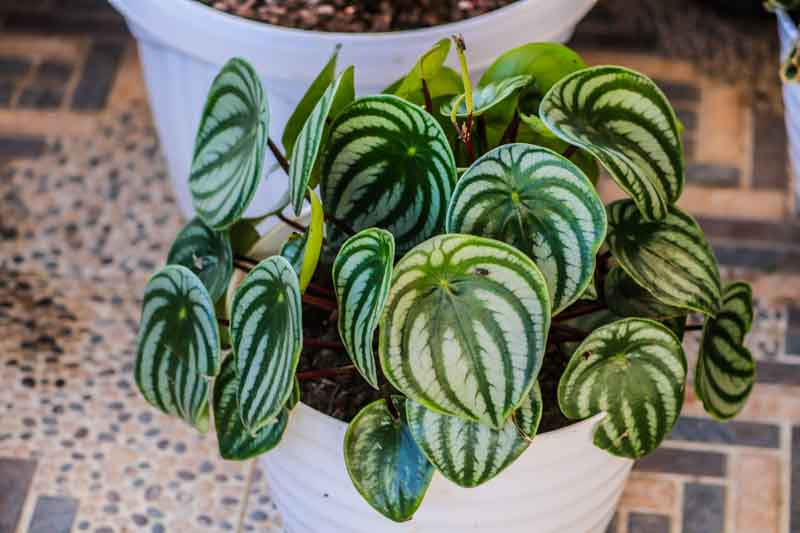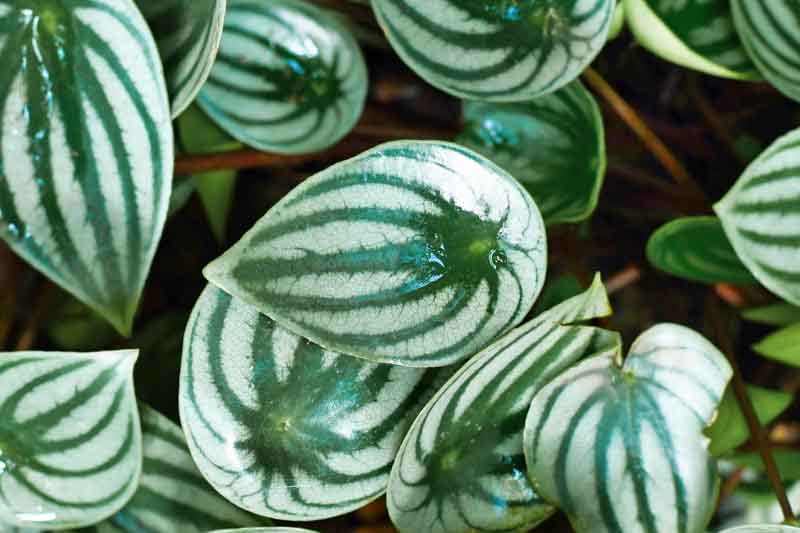Watermelon Peperomia, Watermelon Begonia, Watermelon Pepper, Watermelon Plant, Rugby Football Plant, Peperomia sandersii
Peperomia argyreia, commonly known as the Watermelon Peperomia for its striking resemblance to the rind of a watermelon, is a beloved houseplant that combines ease of care with aesthetic appeal.
Peperomia argyreia is characterized by its round, fleshy leaves that are dark green with silver stripes, mirroring the pattern and texture of a watermelon’s skin. The leaves are attached to red stems, adding a vibrant contrast to the plant’s overall appearance.
Native: This species is native to South America, particularly found in Bolivia, Brazil, Ecuador, and Venezuela, where it thrives in warm, humid conditions under the canopy of larger trees. It belongs to the pepper family (Piperaceae) and is part of a diverse genus with over 1000 species.
Plant Type and Habit: Peperomia argyreia is an evergreen perennial with a compact, rosette-like growth habit, making it an ideal choice for indoor spaces where space may be limited.
Size: Typically, the Watermelon Peperomia reaches a modest size, growing up to 6-8 inches (15-20 cm) in height and spread. Its compact nature makes it perfect for tabletops, desks, and shelves.
Flowers: The plant produces slender, spike-like flower stalks, though they are not particularly showy compared to its striking foliage. The flowers are greenish-white and appear during the summer months.
Foliage: Watermelon Peperomia, showcases round, fleshy leaves marked with silver and dark green stripes, mirroring a watermelon’s rind. The leaves sprout from red stems, contrasting beautifully with the leaf’s glossy surface and vibrant patterning, creating a striking resemblance to the beloved summer fruit.
Hardiness: It is suited for USDA hardiness zones 10 to 12 if grown outdoors. Indoors, it prefers temperatures between 65°F and 75°F (18°C to 24°C) and moderate to high humidity levels.
Award: Recipient of the prestigious Award of Garden Merit of the Royal Horticultural Society.
Uses: With its distinctive foliage, it’s a popular choice for adding a touch of nature and color to indoor environments. Its small size and humidity preferences make it suitable for terrariums and dish gardens.
Toxicity: Watermelon peperomia is non-toxic to cats, dogs, and humans, making it a safe addition to households with pets and children.
Benefits: Though modest, it contributes to improving indoor air quality.

Caring for Peperomia argyreia, commonly known as Watermelon Peperomia, involves meeting its basic needs for light, water, humidity, and soil, mimicking its native environment.
Light: Prefers bright, indirect light. Too much direct sunlight can scorch the leaves, while too little light may cause them to lose vibrancy. A north or east-facing window is ideal, or a spot that receives filtered light.
Soil: Requires well-draining soil that can retain some moisture without becoming waterlogged. A mix containing peat moss, perlite, and vermiculite works well. Ensure the pot has drainage holes to prevent excess water from sitting at the bottom.
Water: Allow the top inch of the soil to dry out between waterings. Overwatering can lead to root rot. Water less frequently in the winter when plant growth naturally slows down.
Temperature and Humidity: Prefers average room temperatures between 65°F and 75°F (18°C to 24°C). Avoid sudden temperature drops and cold drafts. Enjoys high humidity, similar to its native tropical environment. However, it can tolerate average indoor humidity levels. To increase humidity, you can mist the plant regularly, place it on a pebble tray filled with water, or use a humidifier.
Fertilization: Fertilize sparingly, using a diluted liquid houseplant fertilizer once a month during the growing season (spring and summer). Do not fertilize in winter.
Pruning: Pruning is generally not needed but you can trim any yellow or damaged leaves to maintain its appearance and health.
Repotting: Repot only when necessary, typically every 2-3 years or when the plant has outgrown its pot. Choose a pot only slightly larger than the current one to avoid overwatering.
Propagating Watermelon Peperomia is a straightforward process that can be done using leaf cuttings or stem cuttings. Here’s how to do it:
Propagating Watermelon Peperomia is not only a cost-effective way to expand your collection but also a rewarding gardening activity. With patience and proper care, you’ll enjoy new plants that share the same striking features as their parent.

Watermelon Peperomia is generally resilient and low-maintenance but, like all plants, it can encounter its share of pests, diseases, and common problems.
Spider Mites: These tiny pests can be identified by the fine webs they weave on the plant. They cause yellowing or speckled leaves. Increase humidity around the plant and wash it with a strong stream of water. For severe infestations, use insecticidal soap or neem oil.
Mealybugs: These white, cottony pests tend to cluster in leaf axils and under leaves, sucking sap and weakening the plant. Remove with alcohol-dipped cotton swabs or apply neem oil.
Fungus gnat: Overwatering can lead to these pests. Let the soil dry out more between waterings, and use yellow sticky traps to catch adult gnats.
Scale insects: Hard or soft-bodied insects that attach themselves to the stems or leaves, causing yellowing and growth stunting. Scrape off with a fingernail or use a cotton swab dipped in rubbing alcohol. Insecticidal soap or neem oil may also be used.
Root rot: Often a result of overwatering, leading to brown, mushy roots and wilted leaves. Prevent by ensuring good drainage and letting the soil partially dry between waterings. Affected plants may need repotting with fresh soil after cutting away any rotten roots.
Leaf spot: Fungal or bacterial infections causing spots on leaves. Avoid wetting foliage when watering and improve air circulation. Remove affected leaves and treat with fungicides if necessary.
Yellowing Leaves: Overwatering is a common cause. Ensure you’re allowing the soil to dry slightly between waterings.
Curling Leaves: This can indicate the plant is either too dry or exposed to too much direct sunlight. Check the soil moisture and move the plant to a location with bright, indirect light.
Leggy Growth: Insufficient light can cause the plant to stretch towards the light source, resulting in leggy growth. Move your Peperomia to a brighter spot, but away from direct sunlight.
Yes, Watermelon Peperomia (Peperomia argyreia) is predominantly grown as an indoor plant. It thrives in the controlled conditions of indoor environments, where its needs for light, temperature, and humidity can be more easily met than outdoors in most climates.
Watermelon Peperomia prefers bright, indirect sunlight. It does well in locations that receive plenty of light without direct exposure to harsh sun, which can scorch its leaves. A spot near a window with a sheer curtain is ideal. While it can tolerate lower light conditions, its vibrant leaf patterns may become less pronounced in too much shade.
While misting can help increase humidity around the plant, it’s not a requirement for Watermelon Peperomia. This plant does appreciate higher humidity levels, but there are more effective methods to achieve this, such as using a humidifier or placing the plant on a pebble tray with water. If you do mist, do so sparingly to avoid leaf issues such as fungal diseases.
| Hardiness |
10 - 12 |
|---|---|
| Plant Type | Houseplants, Perennials |
| Plant Family | Piperaceae |
| Genus | Peperomia |
| Common names | Watermelon Peperomia |
| Exposure | Partial Sun |
| Season of Interest |
Spring (Early, Mid, Late) Summer (Early, Mid, Late) Fall Winter |
| Height |
6" - 8" (15cm - 20cm) |
| Spread |
6" - 8" (15cm - 20cm) |
| Spacing |
6" - 8" (15cm - 20cm) |
| Maintenance | Low |
| Water Needs | Average |
| Soil Type | Loam |
| Soil pH | Acid, Neutral |
| Soil Drainage | Moist but Well-Drained |
| Characteristics | Showy, Evergreen, Plant of Merit |
| Garden Uses | Patio And Containers |
| Hardiness |
10 - 12 |
|---|---|
| Plant Type | Houseplants, Perennials |
| Plant Family | Piperaceae |
| Genus | Peperomia |
| Common names | Watermelon Peperomia |
| Exposure | Partial Sun |
| Season of Interest |
Spring (Early, Mid, Late) Summer (Early, Mid, Late) Fall Winter |
| Height |
6" - 8" (15cm - 20cm) |
| Spread |
6" - 8" (15cm - 20cm) |
| Spacing |
6" - 8" (15cm - 20cm) |
| Maintenance | Low |
| Water Needs | Average |
| Soil Type | Loam |
| Soil pH | Acid, Neutral |
| Soil Drainage | Moist but Well-Drained |
| Characteristics | Showy, Evergreen, Plant of Merit |
| Garden Uses | Patio And Containers |
How many Peperomia argyreia (Watermelon Peperomia) do I need for my garden?
| Plant | Quantity | |
|---|---|---|
| Peperomia argyreia (Watermelon Peperomia) | N/A | Buy Plants |
Create a membership account to save your garden designs and to view them on any device.
Becoming a contributing member of Gardenia is easy and can be done in just a few minutes. If you provide us with your name, email address and the payment of a modest $25 annual membership fee, you will become a full member, enabling you to design and save up to 25 of your garden design ideas.
Join now and start creating your dream garden!
Create a membership account to save your garden designs and to view them on any device.
Becoming a contributing member of Gardenia is easy and can be done in just a few minutes. If you provide us with your name, email address and the payment of a modest $25 annual membership fee, you will become a full member, enabling you to design and save up to 25 of your garden design ideas.
Join now and start creating your dream garden!